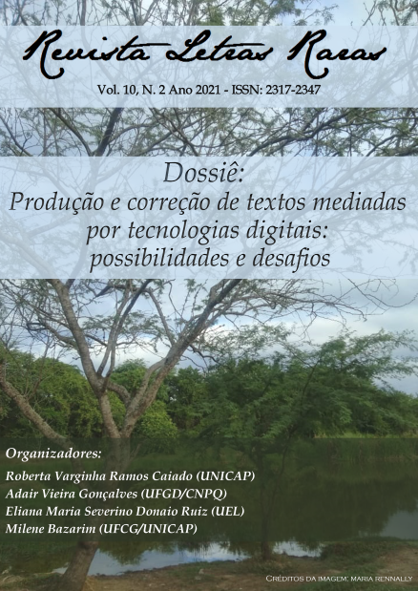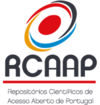Working with digital text in the language classroom in a transmodal perspective
DOI:
https://doi.org/10.5281/zenodo.10121443Palabras clave:
Digital text, Transmodality, Language teachingResumen
Given the intrinsic relation between linguistic, cognitive and social activities, and also the multiple semiotic resources involved in the compositional process, it is necessary to include the nonverbal dimensions in the work with text production and comprehension in language teaching contexts. The affordances of the digital and the emergence of digital-native genres imply, on the one hand, conceptual challenges and offer, on the other, new pathways for the interaction and meaning-making process, which can combine new and conventional forms of writing (HOWELL et al., 2015). This implies working with an expanded notion of text, as defined by Cavalcante et al. (2019) and Cavalcante & Custódio e Filho (2010). Grounded in this notion of text, we reflect on the work with digital texts in the language classroom, based on a transmodal approach (SHIPKA, 2016; HORNER et al., 2015), with the aim of contributing to the discussion of theoretical and pedagogical perspectives in language teaching contexts. Therefore, we present a teaching proposal for language classrooms, exploring the affordances of the digital in the expansion of students’ compositional repertoire and the work with text.
Descargas
Citas
BARTON, D.; LEE, C. Linguagem online: textos e práticas digitais. São Paulo: Parábola, 2015.
BLUHDORN, H; ANDRADE, M. L. Tendências recentes da linguística textual na Alemanha e no Brasil. In: WIESER, H. P; KOCH, I. V (orgs). Linguística Textual: Perspectivas Alemãs. Rio de Janeiro: Nova Fronteira, 2009. p. 17-37.
BRASIL. Ministério da Educação. Base Nacional Comum Curricular. 2018. Disponível em http://basenacionalcomum.mec.gov.br/images/BNCC_EI_EF_110518_versaofinal_site.pdf. Acesso em: ago. 2020.
CAVALCANTE, M. M.; CUSTÓDIO FILHO, V. Revisitando o estatuto do texto. Revista do GELNE, Piauí, v. 12, n. 2, p. 56-71, 2010.
CAVALCANTE, M; et al. O texto e suas propriedades: definindo perspectivas para análise. Revista (Con)Textos Linguísticos, v. 13 n. 25, p. 25-39, 2019.
ELIAS, V. M. Linguística textual e Ensino. In: SOUZA, Edson Rosa; Penhavel, Eduardo; Cintra, Marcos Rogério (Orgs.). Linguística Textual: Interfaces e delimitações – Homenagem a Ingedore Grunfeld Villaça Koch. São Paulo: Cortez, 2017. p. 456-475
ELIAS, V. M; CAVALCANTE, M. M. Linguística textual e estudos do hipertexto: focalizando o contexto e a coerência. In: CAPISTRANO JÚNIOR; R.; LINS, M. P. P; ELIAS, V, M. (Org.). Linguística textual: diálogos interdisciplinares. São Paulo: Labrador/ PPGEL-UFES, 2017.
HORNER, B.; SELFE, C. L; LOCKRIDGE, T. Translinguality, Transmodality, and Difference: Exploring Dispositions and Change in Language and Learning. (Digital monograph). Enculturation Intermezzo, 2015.
HOWELL, E. et al. Writing as Creative Design: Constructing Multimodal Arguments in a Multiliteracies Framework. Journal of Literacy and Technology, Volume 16, Number 1, p. 02-36, May 2015.
KALANTZIS, M.; COPE, B. Language education and multiliteracies. In: MAY, S.; HORNBERGER, N. (Eds.). Encyclopedia of language and education. 2.ed. New York: Springer Science, 2008.
______. The work of writing in the age of its digital reproducibility. Yearbook of the National Society for the Study of Education, 110(1), p. 40-87, 2011.
KOCH, I. V. Desvendando os segredos do texto. 2 ed. São Paulo: Cortez, 2003.
KOCH, I. V.; ELIAS, V. M. O Texto na linguística textual. In: BATISTA, R. O. (org). O texto e seus conceitos. São Paulo: Parábola Editorial, 2016, p. 31-44
LEMKE, J. Letramento metamidiático: transformando significados e mídias. Trabalhos em Linguística Aplicada [online], vol.49, n.2, p.455-479, 2010.
MARCUSCHI, L. A. Gêneros textuais emergentes no contexto da tecnologia digital. Em: MARCUSCHI, L. A. & XAVIER, A. C. (Orgs.) Hipertexto e gêneros digitais. Rio de Janeiro: Editora Lucerna, 2004. p. 13-33
______. Produção textual, análise de gêneros e compreensão. Rio de Janeiro: Parábola, 2008.
MENDONÇA, M. Práticas de análise linguística/ semiótica: reflexões a partir da BNCC. 2020. [Vídeo], Disponível em: https://www.youtube.com/watch?v=fLLeIZgee0c. Acesso em Ago., 2020.
NEW LONDON GROUP. A Pedagogy of Multiliteracies: designing social futures. Harvard Educational Review, v. 66, n. 1, 1996.
PAVEAU, M.-A. L’analyse du discours numérique. Dictionnaire des formes et des pratiques, Paris, Hermann. 2017.
PAVEAU, M.-A. Introduction. Écrire, parler, communiquer en ligne: nos vies sociolangagières connectées. Langage & Société, n° 167 – 2019/2, p. 09-28, 2019.
PAVEAU, M.-A. Feminismos 2.0: Usos tecnodiscursivos da geração conectada. In: COSTA, Julia Lourenço; BARONAS, Roberto Leiser (Orgs.) Feminismos em Convergência: discurso, internet e política. Graciosos Editor: Coimbra, 2020, p. 21-50.
SANTOS, L. W.; TEIXEIRA, C. Linguística Textual e ensino: panorama e perspectivas. In: CAPISTRANO JÚNIOR; R.; LINS, M. P. P; ELIAS, V, M. (Org.). Linguística textual: diálogos interdisciplinares. São Paulo: Labrador/ PPGEL-UFES, 2017.
SHIPKA, J. Transmodality in/and Processes of Making: Changing Dispositions and Practice. College English, Vol. 78, No. 3, Special Issue: Translingual Work in Composition, p. 250-257, 2016.
Descargas
Publicado
Cómo citar
Número
Sección
Licencia
Derechos de autor 2023 Revista Letras Raras

Esta obra está bajo una licencia internacional Creative Commons Atribución-NoComercial 4.0.








